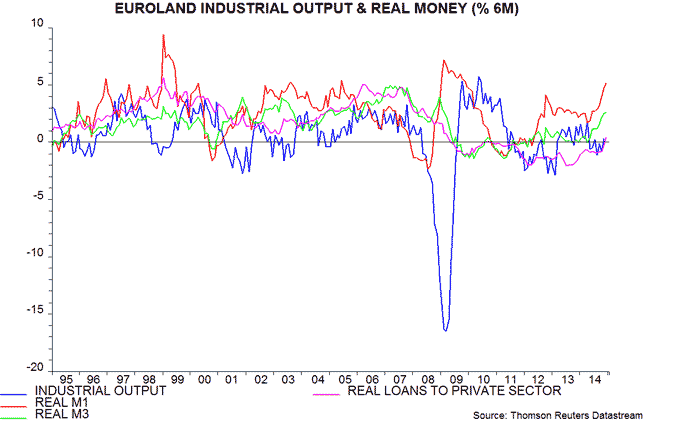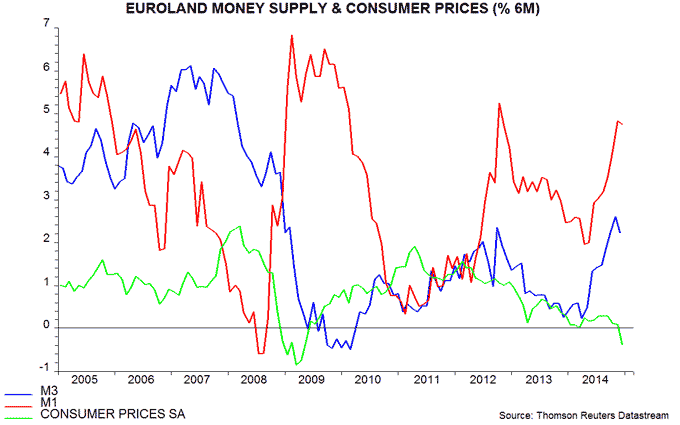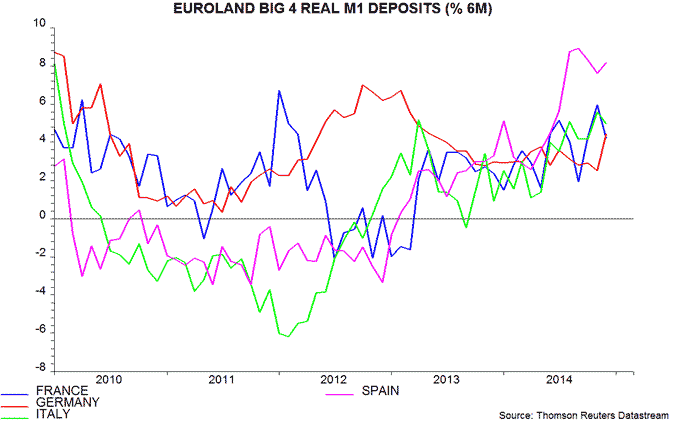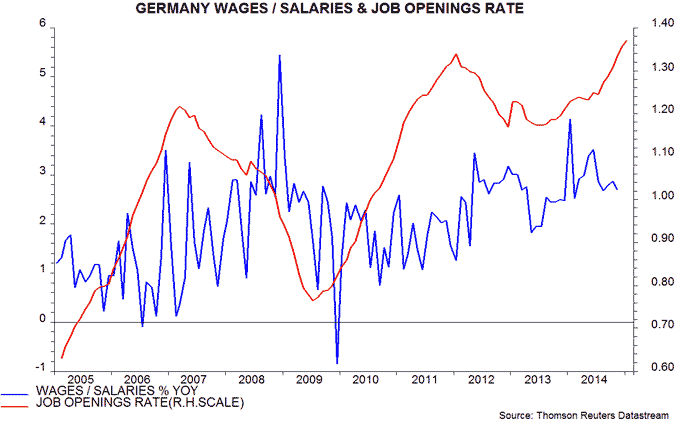Entries from January 25, 2015 - January 31, 2015
Eurozone money trends still upbeat
Eurozone six-month real money growth continued to strengthen in December, supporting the optimistic view here of economic prospects – see also yesterday’s leading indicator report.
The monthly rise in narrow money M1 slowed to 0.3% last month, while the broad M3 measure was unchanged from November. Six-month growth rates, however, remained solid, at 4.8% and 2.2% respectively (9.7% and 4.5% annualised), reflecting strong gains in prior months.
Real growth was boosted by an energy-driven fall in consumer prices in December. Six-month real M1 expansion is now the highest since October 2009, and M3 expansion since February 2009. Real bank lending is also finally growing – see first chart. (The money supply leads the economic cycle, while lending is coincident / lagging.)
Sceptics argue that real money acceleration due to falling prices is not a positive economic signal. There are two responses. First, the recent pick-up in real money growth mainly reflects faster nominal expansion rather than weaker prices – second chart. Secondly, economic growth has strengthened after previous occasions when real money has been boosted by a decline in prices. A surge in real M1 in 2008-09, for example, was also partly due to a fall in energy costs but correctly signalled a strong economic rebound in 2009-10.
The country deposit breakdown shows solid real narrow money trends across the big four economies. Six-month growth in real M1 deposits remains fastest in Spain; Germany had been lagging but caught up with France last month – third chart.
Previous posts argued that QE had limited impact on monetary growth in the US, UK and Japan because it partly involved banks swapping securities for idle reserves at the central bank. The coming ECB programme could be more effective because rising excess reserve holdings will be penalised via the negative deposit facility rate, giving banks a greater incentive to expand lending.
In other Eurozone news today, German unemployment on an internationally-standardised definition fell to a new post-reunification low of 4.8% in December, with a corresponding further rise in the job openings (vacancies) rate. The labour market in Germany appears tighter than in the US / UK, suggesting greater upward pressure on wage growth – fourth chart.
Eurozone leading indicator still rising
The Eurozone longer leading indicator calculated here rose further in December, suggesting that economic growth will rise into mid-2015, at least – see first chart.
The indicator uses the same components as the OECD’s Eurozone leading indicator but is calculated independently and is designed to predict turning points in the six-month rate of change of industrial output*. The December reading is based on partial data but the direction of change is unlikely to be revised. The further increase last month partly reflects recent stronger business survey results in Germany and France**.
The leading indicator turned negative in early 2014 but has been recovering since mid-year, regaining positive territory in September. It usually leads economic momentum by about half a year so the recent improvement in Eurozone coincident data, reflected in a positive reading of the Citigroup surprise index, is occurring on schedule.
The indicator’s revival confirms the hopeful message from monetary trends. Real (i.e. inflation-adjusted) narrow money M1 also leads industrial output by about half a year and its six-month growth reached a five-year high in November – second chart. (December money numbers are released tomorrow.)
The combination of strong real money growth, perhaps to be boosted further by sovereign QE, with weak but rising industrial output expansion suggests a favourable backdrop for Eurozone risk assets.
*The OECD leading indicator predicts the level of output relative to trend rather than growth.
**The December reading of the indicator incorporates January data where available in the calculation of trends in the components.
US slowing on schedule, monetary trends reassuring
A post in September noted that six-month growth in US real narrow money growth had fallen sharply, suggesting a loss of economic momentum in early 2015. This scenario seems to be playing out: Citigroup’s US economic surprise index turned negative at the end of last week after a five-month positive run. The Eurozone index, meanwhile, has recovered and is now above the US level – see first chart.
Should investors worry about US economic weakness? Reassuringly, real narrow money growth rebounded in late 2014 – second chart. It is, however, still lower than a year ago and below the level in the Eurozone. The recovery, moreover, reflects a temporary oil-driven fall in inflation rather than faster nominal monetary expansion. 
Housebuilding activity is a longer leading indicator and is also giving a comforting message, with single-family starts and permits at new recovery highs in December – third chart.
A lower oil price is a net positive for the US economy but the impact is much smaller than in the past and in the Eurozone / Japan – fourth chart. Among the large economies, Korea and India are the biggest winners.
The US economy should perform respectably during the first half of 2015 but growth may fall short of bullish consensus hopes. Positive economic surprises are more likely in the Eurozone / Japan.

